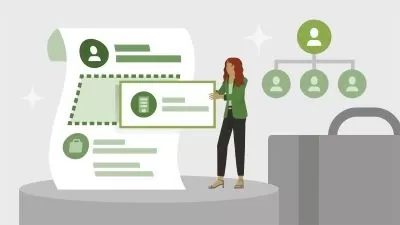Vigilant Leader: Tools & Techniques for Vigilant Leadership
1:44:17
Description
Leverage technology, enhance decision-making, + measure vigilance in Course 6: Tools + Techniques for Vigilant Leaders
What You'll Learn?
- Leverage AI and data analytics for early threat detection and insights.
- Apply decision-making frameworks to handle uncertainty with confidence.
- Develop communication strategies for leading during times of uncertainty.
- Implement real-time environmental scanning using advanced technology tools.
- Measure and evaluate vigilance using KPIs and continuous feedback loops.
Who is this for?
What You Need to Know?
More details
DescriptionWhat You’ll Learn in *Course 6: Tools and Techniques for Vigilant Leadership
---
Hello, I’m Amanda Bennetts, and welcome to *Course 6* of the *Vigilant Leadership* series: *Tools and Techniques for Vigilant Leadership*. In this final course of the series, we’re going to bring everything together by exploring the advanced tools and frameworks that will help you apply vigilant leadership at a higher level.
By this point, you’ve learned how to recognize threats, foster a vigilant organizational culture, and anticipate challenges. Now, it’s time to dive deeper into the practical tools that will allow you to sharpen your decision-making, enhance your communication, and continuously measure your vigilance.
This course will equip you with powerful techniques to handle uncertainty with confidence, and by the end, you’ll have a complete toolkit to lead proactively and strategically in a dynamic environment.
Let’s explore what you’ll learn in this course.
---
### **Leveraging Technology for Vigilant Leadership**
The first area we’ll focus on is how to leverage technology to enhance your vigilance. Today, advanced technologies like AI, machine learning, and big data analytics offer leaders unparalleled insights into emerging threats and opportunities. In this course, you’ll learn how to harness these tools for early detection of risks and the analysis of real-time data.
We’ll explore how AI can be used to predict trends and patterns in your industry, allowing you to stay ahead of potential disruptions. You’ll also discover how big data analytics can help you make data-driven decisions by analyzing customer behavior, market shifts, and operational risks.
By learning how to integrate these technologies into your leadership practices, you’ll be able to identify opportunities and threats faster and with greater accuracy, giving you a competitive advantage.
---
### **Applying Decision-Making Frameworks**
Next, we’ll delve into decision-making frameworks that will help you handle uncertainty with confidence. Uncertainty is one of the greatest challenges leaders face, but with the right framework, you can make informed and decisive choices even in ambiguous situations.
In this course, you’ll learn to apply various decision-making frameworks that balance intuition with data. For example, we’ll explore techniques like the OODA loop (Observe, Orient, Decide, Act) and SWOT analysis to help you process information quickly and take effective action. These tools will allow you to break down complex situations, evaluate risks, and make decisions that align with your long-term strategic goals.
By mastering these decision-making frameworks, you’ll enhance your ability to lead through uncertainty, ensuring that your organization stays resilient and adaptable.
---
### **Enhancing Communication Strategies**
Effective communication is another vital aspect of vigilant leadership, especially in times of uncertainty or change. In this course, you’ll learn how to communicate clearly, transparently, and authentically with your teams, stakeholders, and customers.
We’ll cover strategies for communicating complex information in a way that’s easy to understand, even in high-stress situations. You’ll also discover how to foster trust and confidence within your organization by being open and honest during times of crisis. Leaders who communicate effectively can guide their teams through uncertainty with a steady hand.
We’ll also explore the use of technology in communication, from using data visualization tools to present information clearly to leveraging communication platforms that enhance collaboration across teams.
---
### **Measuring and Evaluating Vigilance**
In the final section of the course, we’ll focus on how to measure and evaluate vigilance in your organization. What gets measured gets improved, and as a vigilant leader, you need to continuously assess how well your organization is detecting and responding to threats.
You’ll learn how to set up key performance indicators (KPIs) that measure your organization’s vigilance. These KPIs can range from how quickly your team responds to a potential threat to how effectively you’re scanning the external environment for new opportunities. We’ll also cover how to create feedback loops within your organization to ensure that vigilance is constantly being refined and improved.
By the end of this section, you’ll have the tools to assess your leadership strategies and make necessary adjustments to keep your organization sharp and ready for future challenges.
---
### **Conclusion**
By the end of *Course 6: Tools and Techniques for Vigilant Leadership*, you’ll have mastered the key tools and frameworks needed to lead with confidence in an unpredictable world. You’ll be equipped to leverage technology, apply decision-making frameworks, communicate effectively, and measure your organization’s vigilance.
This course brings together everything you’ve learned throughout the *Vigilant Leadership* series, providing you with a comprehensive toolkit to lead proactively and strategically. I’m excited to see how these advanced tools will help you lead your organization to success, no matter what the future holds.
Let’s get started!
Who this course is for:
- **Experienced Leaders:** Managers, directors, and executives who want to sharpen their leadership skills by learning how to anticipate challenges and make proactive, informed decisions in a rapidly changing environment.
- **Aspiring Leaders:** Professionals aiming for leadership roles who want to develop the strategic foresight and decision-making capabilities necessary to lead teams and organizations with confidence.
- **HR Professionals:** Individuals responsible for developing leadership programs within their organizations who seek to foster a culture of vigilance and empower teams to identify and respond to emerging threats.
- **Entrepreneurs and Business Owners:** Those who want to enhance their ability to navigate uncertainty, drive innovation, and build resilient, future-ready businesses.
- **Who is it not suitable for?** - **Complete Beginners:** This series assumes a foundational understanding of business and leadership principles. Those new to leadership may benefit from starting with more basic leadership courses before diving into this series.
What You’ll Learn in *Course 6: Tools and Techniques for Vigilant Leadership
---
Hello, I’m Amanda Bennetts, and welcome to *Course 6* of the *Vigilant Leadership* series: *Tools and Techniques for Vigilant Leadership*. In this final course of the series, we’re going to bring everything together by exploring the advanced tools and frameworks that will help you apply vigilant leadership at a higher level.
By this point, you’ve learned how to recognize threats, foster a vigilant organizational culture, and anticipate challenges. Now, it’s time to dive deeper into the practical tools that will allow you to sharpen your decision-making, enhance your communication, and continuously measure your vigilance.
This course will equip you with powerful techniques to handle uncertainty with confidence, and by the end, you’ll have a complete toolkit to lead proactively and strategically in a dynamic environment.
Let’s explore what you’ll learn in this course.
---
### **Leveraging Technology for Vigilant Leadership**
The first area we’ll focus on is how to leverage technology to enhance your vigilance. Today, advanced technologies like AI, machine learning, and big data analytics offer leaders unparalleled insights into emerging threats and opportunities. In this course, you’ll learn how to harness these tools for early detection of risks and the analysis of real-time data.
We’ll explore how AI can be used to predict trends and patterns in your industry, allowing you to stay ahead of potential disruptions. You’ll also discover how big data analytics can help you make data-driven decisions by analyzing customer behavior, market shifts, and operational risks.
By learning how to integrate these technologies into your leadership practices, you’ll be able to identify opportunities and threats faster and with greater accuracy, giving you a competitive advantage.
---
### **Applying Decision-Making Frameworks**
Next, we’ll delve into decision-making frameworks that will help you handle uncertainty with confidence. Uncertainty is one of the greatest challenges leaders face, but with the right framework, you can make informed and decisive choices even in ambiguous situations.
In this course, you’ll learn to apply various decision-making frameworks that balance intuition with data. For example, we’ll explore techniques like the OODA loop (Observe, Orient, Decide, Act) and SWOT analysis to help you process information quickly and take effective action. These tools will allow you to break down complex situations, evaluate risks, and make decisions that align with your long-term strategic goals.
By mastering these decision-making frameworks, you’ll enhance your ability to lead through uncertainty, ensuring that your organization stays resilient and adaptable.
---
### **Enhancing Communication Strategies**
Effective communication is another vital aspect of vigilant leadership, especially in times of uncertainty or change. In this course, you’ll learn how to communicate clearly, transparently, and authentically with your teams, stakeholders, and customers.
We’ll cover strategies for communicating complex information in a way that’s easy to understand, even in high-stress situations. You’ll also discover how to foster trust and confidence within your organization by being open and honest during times of crisis. Leaders who communicate effectively can guide their teams through uncertainty with a steady hand.
We’ll also explore the use of technology in communication, from using data visualization tools to present information clearly to leveraging communication platforms that enhance collaboration across teams.
---
### **Measuring and Evaluating Vigilance**
In the final section of the course, we’ll focus on how to measure and evaluate vigilance in your organization. What gets measured gets improved, and as a vigilant leader, you need to continuously assess how well your organization is detecting and responding to threats.
You’ll learn how to set up key performance indicators (KPIs) that measure your organization’s vigilance. These KPIs can range from how quickly your team responds to a potential threat to how effectively you’re scanning the external environment for new opportunities. We’ll also cover how to create feedback loops within your organization to ensure that vigilance is constantly being refined and improved.
By the end of this section, you’ll have the tools to assess your leadership strategies and make necessary adjustments to keep your organization sharp and ready for future challenges.
---
### **Conclusion**
By the end of *Course 6: Tools and Techniques for Vigilant Leadership*, you’ll have mastered the key tools and frameworks needed to lead with confidence in an unpredictable world. You’ll be equipped to leverage technology, apply decision-making frameworks, communicate effectively, and measure your organization’s vigilance.
This course brings together everything you’ve learned throughout the *Vigilant Leadership* series, providing you with a comprehensive toolkit to lead proactively and strategically. I’m excited to see how these advanced tools will help you lead your organization to success, no matter what the future holds.
Let’s get started!
Who this course is for:
- **Experienced Leaders:** Managers, directors, and executives who want to sharpen their leadership skills by learning how to anticipate challenges and make proactive, informed decisions in a rapidly changing environment.
- **Aspiring Leaders:** Professionals aiming for leadership roles who want to develop the strategic foresight and decision-making capabilities necessary to lead teams and organizations with confidence.
- **HR Professionals:** Individuals responsible for developing leadership programs within their organizations who seek to foster a culture of vigilance and empower teams to identify and respond to emerging threats.
- **Entrepreneurs and Business Owners:** Those who want to enhance their ability to navigate uncertainty, drive innovation, and build resilient, future-ready businesses.
- **Who is it not suitable for?** - **Complete Beginners:** This series assumes a foundational understanding of business and leadership principles. Those new to leadership may benefit from starting with more basic leadership courses before diving into this series.
User Reviews
Rating

Udemy
View courses Udemy- language english
- Training sessions 20
- duration 1:44:17
- Release Date 2025/01/16









